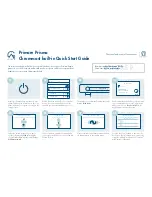
Page 10
without compensation. In fact, if you build a supersymmetric circuit with multiple gain stages, it
does not work as well.
In 1993 I attempted to build the first power amplifier using this principle, but it was not
successful. Ironically, the supersymmetric concept not only allows for very simple gain circuits,
but it requires them for good performance. My first efforts did not use a simple enough
approach, although I didn’t realize it at the time. A more modest version of the circuit found its
way into a preamplifier, the Aleph P. Ultimately the power amplifier was set aside, as we were
very busy building Aleph single-ended Class A amplifiers.
In 1997 I decided to build a state-of-the-art
very high power
amplifier, the X1000, a project not
particularly appropriate for the single-ended Class A approach (believe me, you don’t want to
own an amplifier idling at 3000 watts per channel). So I pulled out the files on patent
# 5,376,899 and took another look. Extensive testing of potential circuits revealed that the
best topology for the front end of the amplifier is what we refer to as “balanced single-ended”, a
phrase I use to refer to differential use of two single-ended Class A gain devices. The classic
differential pair of transistors (or tubes, for that matter) is just such a topology.
“Balanced single-ended” is an oxymoron in the sense that most single-ended enthusiasts
believe that the most desirable characteristic of single-ended circuits is their generation of
even-order distortion components by virtue of their asymmetry. Purists will point out that a
balanced version of a single-ended circuit will experience cancellation of noise and even-order
components. Just so. Interestingly, the single-ended nature of each half of the balanced
circuit doesn’t give rise to much in the way of odd-order distortion, and when the even-order
components and noise are cancelled there isn’t much distortion and noise left. In any case,
“Balanced single-ended” is a phrase that accurately describes the circuit.
For the amplifier’s front end, a balanced single-ended gain stage was developed which used
just a differential pair of Mosfet gain devices. These were biased by constant current sources
and cascoded for maximum performance and given local feedback and a Supersymmetric
connection. After years of trying alternative arrangements, it ended up virtually identical to the
schematic on the cover page of the patent, which is reproduced later in this manual.
The front end, which develops all the voltage gain for the amplifier, then presents this voltage
to a large bank of follower Mosfet power transistors. Originally it was assumed that we would
have to enclose this output stage in a feedback loop to get the performance we wanted, but
ultimately we found that we could operate it without feedback as long as we put a healthy bias
current through it. For these amplifiers this is about 600 watts worth. This is not pure Class A
operation in the context of 1000 watts output, but it has proven to be the appropriate amount.
The result is a series of amplifiers using the supersymmetric topology delivering up to 1000
watts per channel into 8 ohms with good distortion and noise figures. If you are a little less
fussy about distortion, you will get twice that into 4 ohms. This is accomplished with only two
gain stages and no feedback.
People inevitably will ask how this relates to bridged amplifiers in general, and the balanced
amplifier offerings of other companies. It is similar in that both terminals of the output to the
speaker are “live”; neither of them is grounded.































